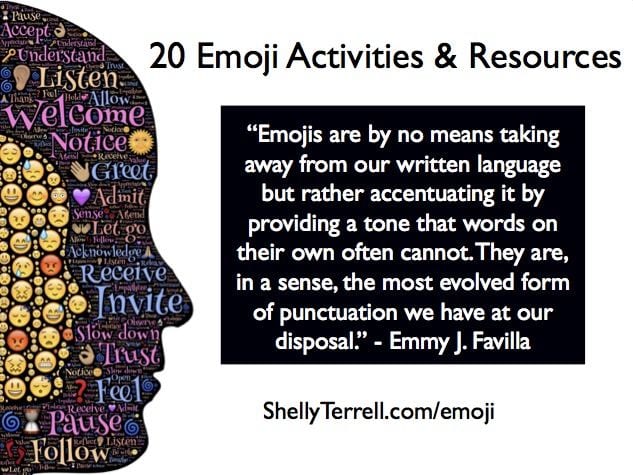
Today is World Emoji Day and to celebrate I’m sharing 20 emoji activities, my slide presentation, and resources to engage your learners. Emojis are an important part of our students’ digital culture and the way students humanize time spent communicating with others constantly through a machine. Emojis allow students to express themselves, share their personalities, and add emotion to their messages. Emojis also represent an international language. Around the world we understand with symbols like a smiley face, angry face, or laughing face mean. Emojis also continue to become more culturally inclusive and now allow us to choose a skin tone. Discover more ideas, tips, and free resources for teaching with emojis here.
If you like these ideas, take one of my courses or check out one of my books. Ask me about training your teachers, ShellyTerrell@gmail.com!
Learn Emoji
- Emojipedia is a useful site for discovering what each emoji means and keeping up with the latest in emoji developments and resources. Students can also type in what they want to express and find recommended emojis.
- Duolingo offers a free course for anyone to learn emoji in 5 minutes.
Activities and Resources
These web tools and resources have a free version and work on multiple devices, except for the books mentioned.
- Get students to create their own emoji word problems then see if their peers can translate and solve them.
- Solve Emoji has several emoji math puzzles for students to solve.
- Bill Nye has 6 YouTube videos where he explains science with emojis. Topics include the science behind superheroes and holograms.
- Students can learn the periodic table of elements by representing each element with an emoji and explaining the connection. See this example created by a scientist.
- Use emoji writing prompts. Show students 3 to 5 different emojis and have them create a story or poem based on these emojis. See my example here.
- Eric Curts has created an emoji prompt generator to help out with this activity here.
- Students can use image editing apps, like Snapchat or Twitter, to snap pictures of their readings and annotate them with emojis.
- For example, students can add a ? next to one of the author’s ideas they like, a ? to symbolize disagreement, or any of these emojis, ?♀️?❓?♂️, to highlight words or areas of the text they don’t understand.
- This post explains how I get students to annotate their readings and shows examples.
- Edji is a great annotation tool allows students to highlight and comment on readings with written text or emojis.
- Assess student understanding with emojis. Here are a ton of emoji exit ticket examples. You can also download and use this example.
- Teachers can provide feedback with emojis. Showbie is a learning management system where students can submit work and teachers can provide feedback in a variety of ways, including with emojis.
- Students can provide feedback to peer work using emojis.
- Build vocabulary with emoji flash cards! Students can create flashcards using emojis to define the words.
- Students can also translate part of their readings into emoji. Emojidick and the OMG Shakespeare series are examples of literature translated into emoji.
- Here is an emoji get to know you activity that also works well for an online course. Get students to answer the following with emojis. Current mood: ?
How many pets: ?Favorite holiday: ?Favorite emojis: ?
- Emoji predictions- List 3 key details about any historic person or topic in emoji and students will make guesses about what they are learning based on the emojis.
- Promote active learning with student devices with Google’s Emoji Scavenger Hunt. Emojis are projected in the real world and students must find them.
- Emoji Charades is a free iOS app in which students play charades with others. Instead of acting out the topic, they express the topic in emoji for others to guess.
- Google Chrome has an Emoji Keyboard extension to use for writing emojis on a computer.
- Emojitranslate.com allows you to copy and paste text and translates it into emoji for you. This is a starting tool, but students will have to add more emojis to the translation.
- With this tool they can begin translating modernized versions of fairytales into emoji or their own imagined stories. See this example of Frozen translated into emoji- Youtube.com/watch?v=qjycf7h4KZM
Challenge: Engage students with any of these emoji activities.
Subscribe for FREE to receive regular updates!
?Get your copy of Hacking Digital Learning or The 30 Goals Challenge or take a fully accredited online course for graduate credit (Online Learning Best Practices, Connected Educators or TESOL Methodologies)!








[…] 20+ Emoji Activities and Resources for Teaching Math, Science, and English – a very helpful blogpost by Shelly Terrell with a host of ideas for making use of emojis in education. The ideas can be adapted across many curricular areas. Shelley links to other useful resources and tools, as well as additional posts about how emojis can be used including her “Teaching the Emoji Generation” article which also links to many other articles, resources and tools. […]